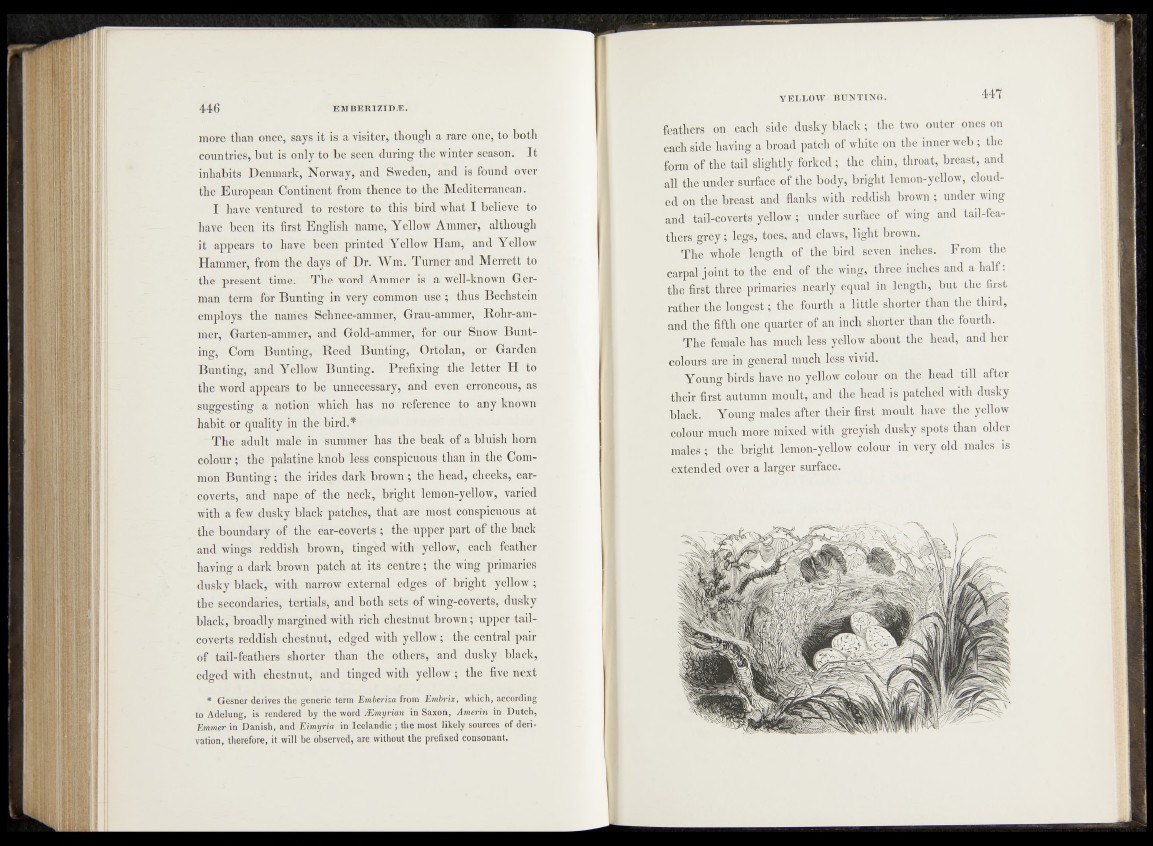
more than once, says it is a visiter, though a rare one, to both
countries, but is only to be seen during the winter season. It
inhabits Denmark, Norway, and Sweden, and is found over
the European Continent from thence to the Mediterranean.
I have ventured to restore to this bird what I believe to
have been its first English name, Yellow Ammer, although
it appears to have been printed Yellow Ham, and Yellow
Hammer, from the days of Dr. Wm. Turner and Merrett to
the present time. The word Ammer is a well-known German
term for Bunting in very common use ; thus Bechstein
employs the names Schnee-ammer, Grau-ammer, Rohr-am-
mer, Garten-ammer, and Gold-ammer, for our Snow Bunting,
Com Bunting, Reed Bunting, Ortolan, or Garden
Bunting, and Yellow Bunting. Prefixing the letter H to
the word appears to be unnecessary, and even erroneous, as
suggesting a notion which has no reference to any known
habit or quality in the bird.*
The adult male in summer has the beak of a bluish horn
colour ; the palatine knob less conspicuous than in the Common
Bunting; the irides dark brown; the head, cheeks, ear-
coverts, and nape of the neck, bright lemon-yellow, varied
with a few dusky black patches, that are most conspicuous at
the boundary of the ear-coverts ; the upper part of the back
and wings reddish brown, tinged with yellow, each feather
having a dark brown patch at its centre; the wing primaries
dusky black, with narrowr external edges of bright yellow ;
the secondaries, tertials, and both sets of wing-coverts, dusky
black, broadly margined with rich chestnut brown; upper tail-
coverts reddish chestnut, edged with yellow; the central pair
of tail-feathers shorter than the others, and dusky black,
edged with chestnut, and tinged with yellow ; the five next
* Gesner derives the generic term Emberiza from Embrix, which, according
to A delung, is rendered by the word JEmyrian in Saxon, Amerin in Dutch,
Emmer in Danish, and Eimyria in Icelandic ; the most likely sources of derivation,
therefore, it will be observed, are without the prefixed consonant.
feathers on each side dusky black; the two outer ones on
each side having a broad patch of white on the inner web ; the
form of the tail slightly forked; the chin, throat, breast, and
all the under surface of the body, bright lemon-yellow, clouded
on the breast and flanks with reddish brown; under wing
and tail-coverts yellow ; under surface of wing and tail-feathers
grey; legs, toes, and claws, light brown.
The whole length of the bird seven inches. From the
carpal joint to the end of the wing, three inches and a half:
the first three primaries nearly equal in length, but the first
rather the longest; the fourth a little shorter than the third,
and the fifth one quarter of an inch shorter than the fourth.
The female has much less yellow about the head, and her
colours are in general much less vivid.
Young birds have no yellow colour on the head till after
their first autumn moult, and the head is patched with dusky
black. Young males after their first moult have the yellow
colour much more mixed with greyish dusky spots than older
males ; the bright lemon-yellow colour in very old males is
extended over a larger surface.